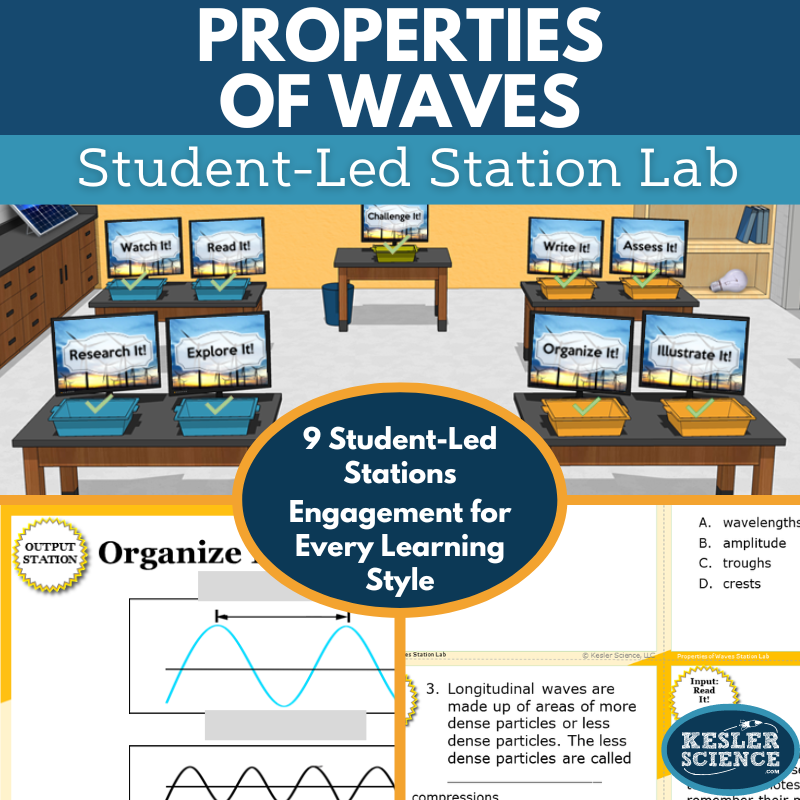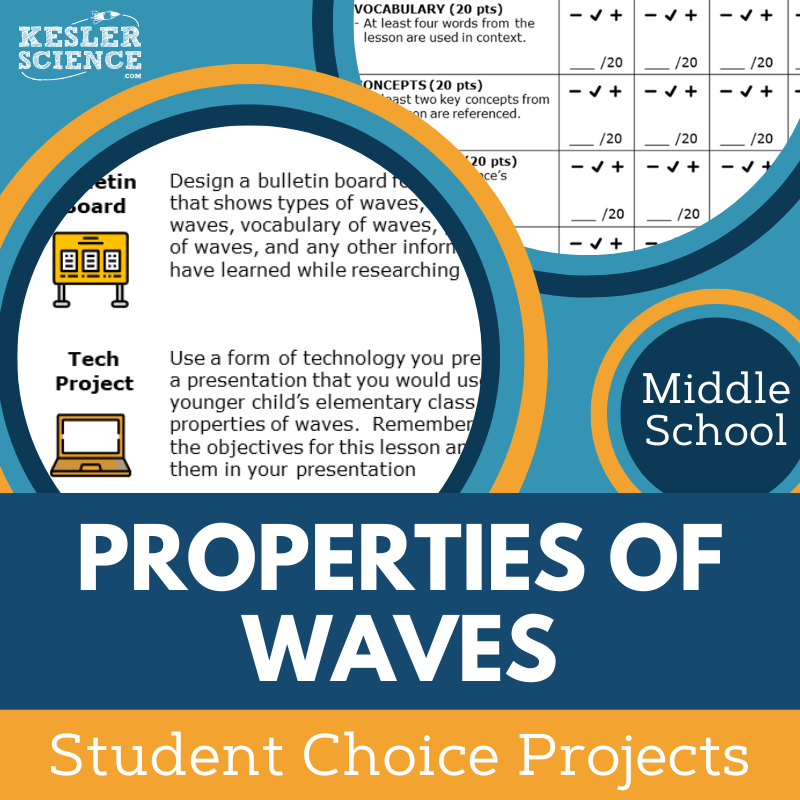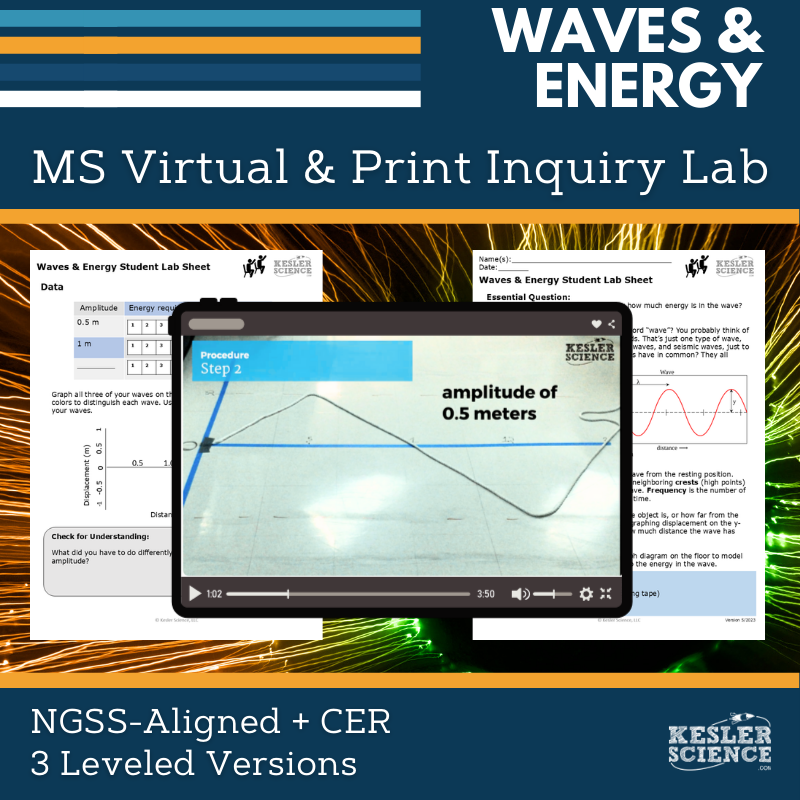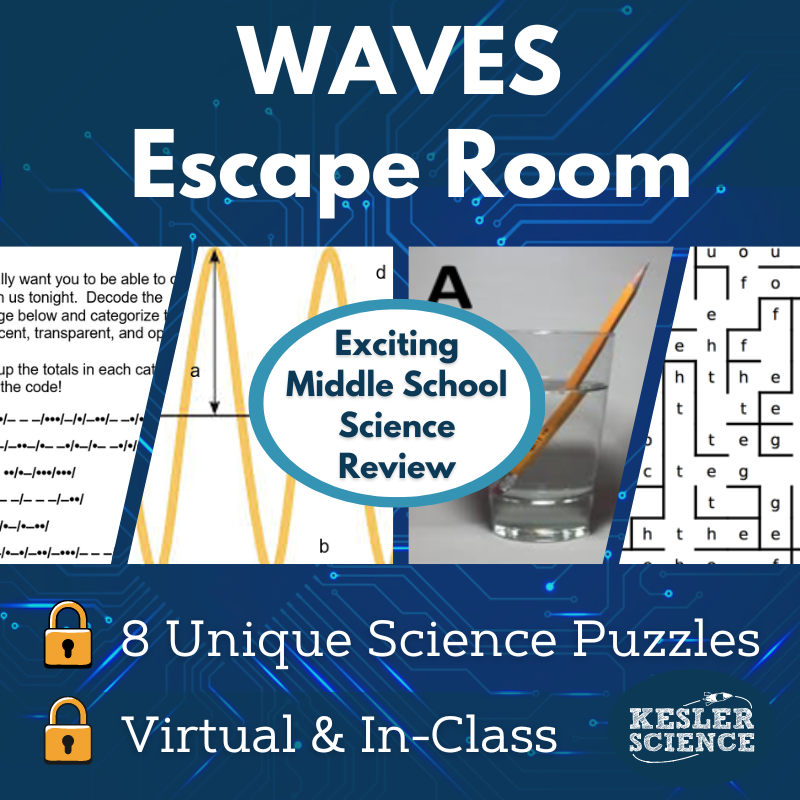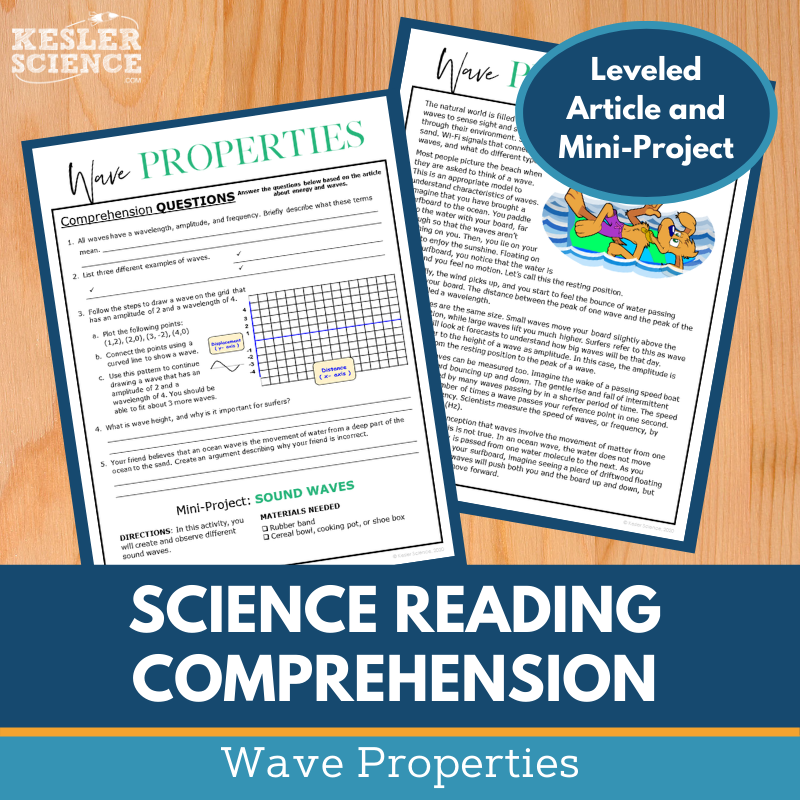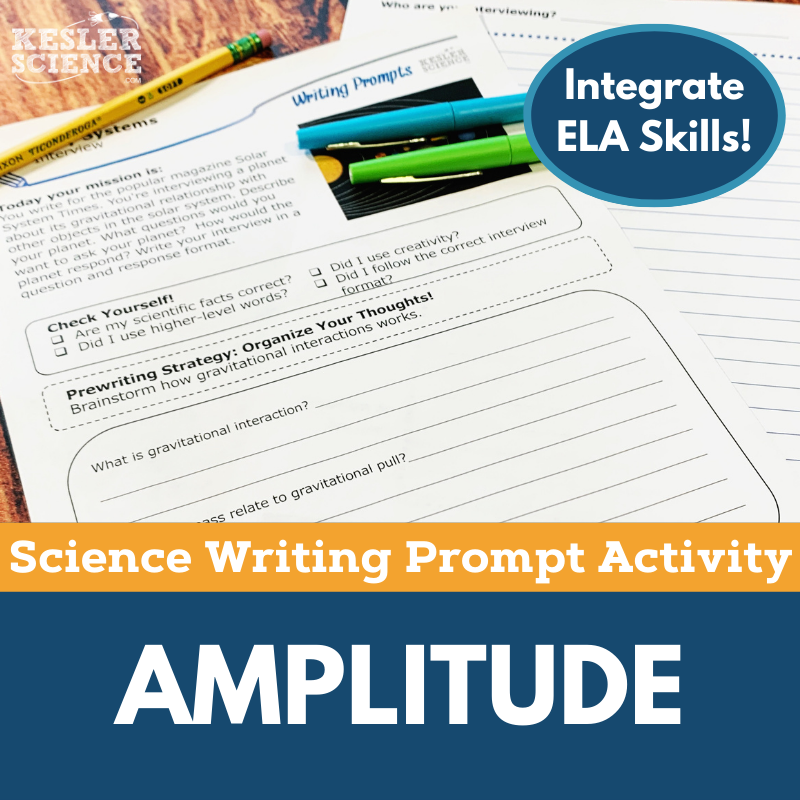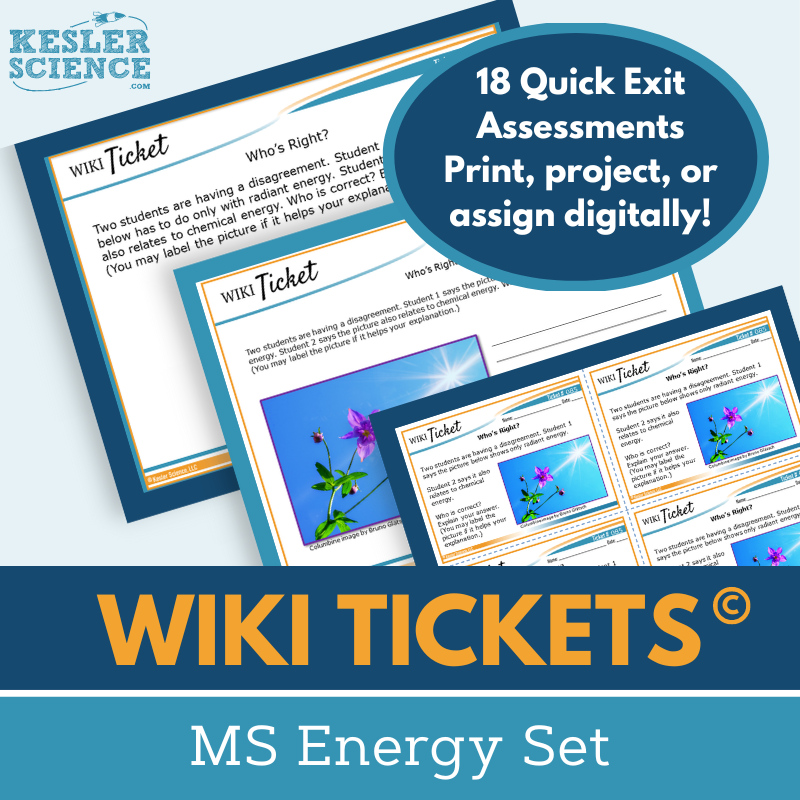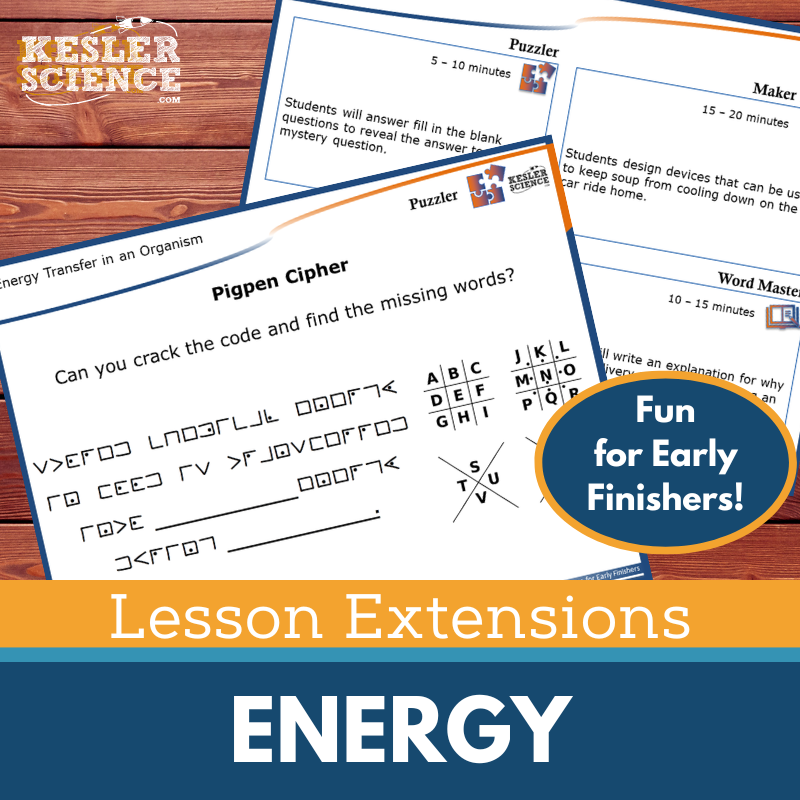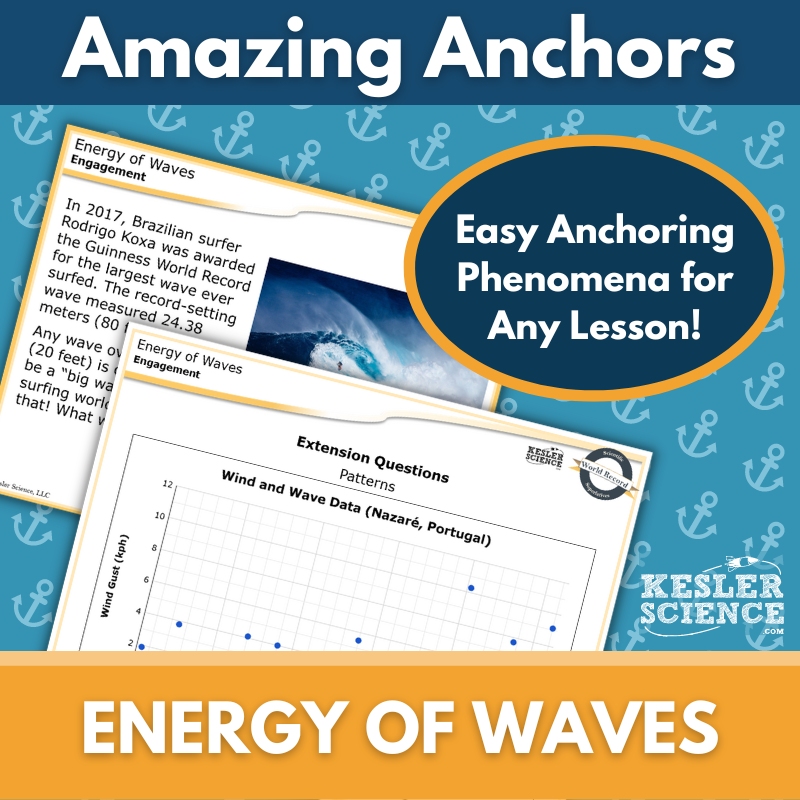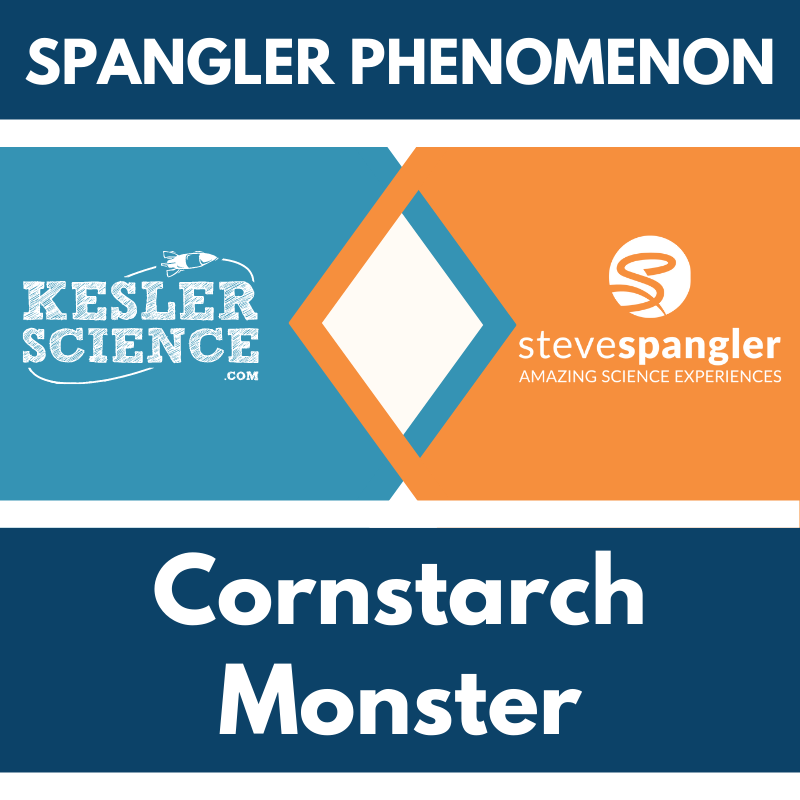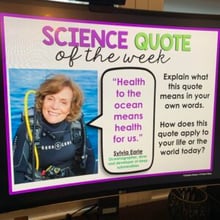Waves & Energy Activities for Middle School Science
Help your students master waves and energy with this engaging, student-led 5E lesson! Designed for middle school classrooms, this comprehensive unit covers the interaction of matter and energy in waves, the three main types of mechanical waves, and key wave properties. The resources below will give students a comprehensive understanding of waves and energy. All of the following materials are also included in the Kesler Science Membership.
The Kesler Science Properties of Waves 5E Lesson is a comprehensive, student-led unit designed for middle school classrooms. It includes editable presentations, worksheets, choice projects, and assessments aligned with TEKS and NGSS. This multiday lesson requires minimal prep and supports differentiated learning with multimodal resources, printable and digital formats, and Spanish translations of key materials.
Students explore essential questions about the interaction of matter and energy in waves, the three main types of mechanical waves, and wave properties. The 5E Model structure guides learning through engagement activities, a hands-on exploration station lab with nine differentiated stations, and interactive explanations using editable PowerPoints and notebooks. Elaboration activities allow students to extend their understanding through choice projects, while STAAR 2.0-aligned assessments ensure comprehension.
The lesson is highly flexible, supporting both in-class and virtual learning. Differentiated materials, multimodal instruction, and student-centered exploration make this resource engaging and effective for middle school science instruction.
The Kesler Science Properties of Waves 5E Lesson is a comprehensive, student-led unit designed for middle school classrooms. It includes editable presentations, worksheets, choice projects, and assessments aligned with TEKS and NGSS. This multiday lesson requires minimal prep and supports differentiated learning with multimodal resources, printable and digital formats, and Spanish translations of key materials.
Students explore essential questions about the interaction of matter and energy in waves, the three main types of mechanical waves, and wave properties. The 5E Model structure guides learning through engagement activities, a hands-on exploration station lab with nine differentiated stations, and interactive explanations using editable PowerPoints and notebooks. Elaboration activities allow students to extend their understanding through choice projects, while STAAR 2.0-aligned assessments ensure comprehension.
The lesson is highly flexible, supporting both in-class and virtual learning. Differentiated materials, multimodal instruction, and student-centered exploration make this resource engaging and effective for middle school science instruction.
Engage your middle school students with this student-led station lab on the properties of waves. This hands-on, interactive lesson allows students to develop and use models to describe how waves are reflected, absorbed, or transmitted through various materials while directing their own learning.
The station lab includes nine differentiated stations that provide multimodal ways to explore wave properties. Input stations introduce concepts through hands-on demonstrations, research, readings, and videos, while output stations help students demonstrate understanding through organizing information, illustrating models, writing responses, and completing assessments. A challenge station offers extension activities for early finishers.
Designed for both in-class and virtual learning, this low-prep resource includes all necessary signage, literature, task cards, and digital adaptations in PowerPoint and Google Slides. Differentiated reading passages in English and Spanish support diverse learners, making this an engaging and adaptable addition to your science curriculum.
Engage your middle school students with this student-led station lab on the properties of waves. This hands-on, interactive lesson allows students to develop and use models to describe how waves are reflected, absorbed, or transmitted through various materials while directing their own learning.
The station lab includes nine differentiated stations that provide multimodal ways to explore wave properties. Input stations introduce concepts through hands-on demonstrations, research, readings, and videos, while output stations help students demonstrate understanding through organizing information, illustrating models, writing responses, and completing assessments. A challenge station offers extension activities for early finishers.
Designed for both in-class and virtual learning, this low-prep resource includes all necessary signage, literature, task cards, and digital adaptations in PowerPoint and Google Slides. Differentiated reading passages in English and Spanish support diverse learners, making this an engaging and adaptable addition to your science curriculum.
The Properties of Waves Student Choice Projects lesson allows middle school students to select a project that matches their preferred output style. A project page outlines six different student-led options plus a “design your own” project, with an editable rubric for teacher, peer, or self-assessment.
These flexible, multimodal projects provide creative ways for students to demonstrate their understanding. Two versions of the project page support differentiation, with modified options for students needing remediation and challenge options for advanced learners. Teachers can adjust the rubric to fit grading needs.
The projects require standard classroom supplies such as paper, markers, and scissors, with many options available for digital completion.
The Properties of Waves Student Choice Projects lesson allows middle school students to select a project that matches their preferred output style. A project page outlines six different student-led options plus a “design your own” project, with an editable rubric for teacher, peer, or self-assessment.
These flexible, multimodal projects provide creative ways for students to demonstrate their understanding. Two versions of the project page support differentiation, with modified options for students needing remediation and challenge options for advanced learners. Teachers can adjust the rubric to fit grading needs.
The projects require standard classroom supplies such as paper, markers, and scissors, with many options available for digital completion.
The Waves and Energy Inquiry Lab aligns with NGSS MS-PS4-1, helping students model and measure the amplitude of transverse waves to understand their relationship with energy. This lab offers both a hands-on printed experiment and an interactive digital version with a pre-recorded video demonstration.
Students construct a simple wave model using rope and measure its amplitude while keeping wavelength and frequency constant. Comprehension questions, Claim-Evidence-Reasoning (C.E.R.) prompts, and a reflection section guide their learning. The lab includes three differentiated versions: Dependent for on-level learners with guided inquiry, Modified with structured support and simplified questioning, and Independent for advanced students who lead their own exploration.
The print version provides step-by-step procedures for in-person experimentation, while the digital version is an interactive PowerPoint compatible with Google Slides and major LMS platforms. The digital format requires no materials, making it ideal for students without access to physical supplies.
Teachers benefit from editable PowerPoints, answer keys, differentiated materials, and flexible delivery options. Additional teacher resources include standards alignment, objectives, prep time estimates, and procedural guidance. The digital files include a video recording of the lab procedure, ensuring an engaging and accessible experience for all students.
The Waves and Energy Inquiry Lab aligns with NGSS MS-PS4-1, helping students model and measure the amplitude of transverse waves to understand their relationship with energy. This lab offers both a hands-on printed experiment and an interactive digital version with a pre-recorded video demonstration.
Students construct a simple wave model using rope and measure its amplitude while keeping wavelength and frequency constant. Comprehension questions, Claim-Evidence-Reasoning (C.E.R.) prompts, and a reflection section guide their learning. The lab includes three differentiated versions: Dependent for on-level learners with guided inquiry, Modified with structured support and simplified questioning, and Independent for advanced students who lead their own exploration.
The print version provides step-by-step procedures for in-person experimentation, while the digital version is an interactive PowerPoint compatible with Google Slides and major LMS platforms. The digital format requires no materials, making it ideal for students without access to physical supplies.
Teachers benefit from editable PowerPoints, answer keys, differentiated materials, and flexible delivery options. Additional teacher resources include standards alignment, objectives, prep time estimates, and procedural guidance. The digital files include a video recording of the lab procedure, ensuring an engaging and accessible experience for all students.
The Waves Escape Room is an engaging activity that allows students to demonstrate their understanding of light and sound waves in a fun, interactive way. Students should be familiar with wave properties and vocabulary such as transparent, translucent, opaque, transverse, longitudinal, light waves, and sound waves before participating.
Unlike traditional escape rooms, teachers have full control over which of the eight independent puzzles to use and their sequence, making it adaptable for different class periods. The activity can be run using manila envelopes for a simple setup or with locks and a storage box for a more immersive experience. A digital version is available for online learning through PowerPoint or Google Slides, and a printable version can be assigned for at-home use.
This resource includes teacher directions, a detailed answer key, a digital answer sheet, an editable teacher version, and a video challenge to enhance engagement. Students will work through eight unique puzzles using all provided printable props, with reward templates, prize ideas, and photo-ready signs to celebrate their success. This standards-aligned escape room will keep students engaged and excited about learning wave properties.
The Waves Escape Room is an engaging activity that allows students to demonstrate their understanding of light and sound waves in a fun, interactive way. Students should be familiar with wave properties and vocabulary such as transparent, translucent, opaque, transverse, longitudinal, light waves, and sound waves before participating.
Unlike traditional escape rooms, teachers have full control over which of the eight independent puzzles to use and their sequence, making it adaptable for different class periods. The activity can be run using manila envelopes for a simple setup or with locks and a storage box for a more immersive experience. A digital version is available for online learning through PowerPoint or Google Slides, and a printable version can be assigned for at-home use.
This resource includes teacher directions, a detailed answer key, a digital answer sheet, an editable teacher version, and a video challenge to enhance engagement. Students will work through eight unique puzzles using all provided printable props, with reward templates, prize ideas, and photo-ready signs to celebrate their success. This standards-aligned escape room will keep students engaged and excited about learning wave properties.
This Wave Properties Science Reading Comprehension Lesson helps students explore how wave amplitude relates to energy through a nonfiction article on wave properties. Designed for middle school, the leveled passage enhances science literacy and reading comprehension.
The resource includes two leveled articles (Lexile 1100-1300), five to seven comprehension questions, a hands-on mini-project, and a Cornell notes template. Students observe and create different sound waves to reinforce learning.
Ideal for sub plans, ISS, extra credit, or whole-class instruction, this resource supports virtual and in-person learning through platforms like Google Classroom, MS Teams, Schoology, and Canvas. It fosters critical thinking, discussion, and textual analysis while strengthening key science concepts.
This Wave Properties Science Reading Comprehension Lesson helps students explore how wave amplitude relates to energy through a nonfiction article on wave properties. Designed for middle school, the leveled passage enhances science literacy and reading comprehension.
The resource includes two leveled articles (Lexile 1100-1300), five to seven comprehension questions, a hands-on mini-project, and a Cornell notes template. Students observe and create different sound waves to reinforce learning.
Ideal for sub plans, ISS, extra credit, or whole-class instruction, this resource supports virtual and in-person learning through platforms like Google Classroom, MS Teams, Schoology, and Canvas. It fosters critical thinking, discussion, and textual analysis while strengthening key science concepts.
The Amplitude Science Writing Activity engages middle school students in a creative songwriting exercise to reinforce their understanding of wave amplitude and its relationship to energy. Aligned with NGSS MS-PS4-1, this low-prep, student-centered activity supports both in-person and virtual learning while enhancing science reasoning and exploration.
This resource includes teacher directions with answer guides, project ideas, and rubrics, as well as projection and print handouts in both full-sized and half-sheet formats. A digital interactive version, compatible with PowerPoint and Google Slides, allows students to complete the activity in edit mode for flexible learning. Ideal for cross-curricular integration, pre-test assessments, student choice projects, or differentiation, this writing prompt fosters engagement and creativity, making it a valuable addition to any science classroom.
The Amplitude Science Writing Activity engages middle school students in a creative songwriting exercise to reinforce their understanding of wave amplitude and its relationship to energy. Aligned with NGSS MS-PS4-1, this low-prep, student-centered activity supports both in-person and virtual learning while enhancing science reasoning and exploration.
This resource includes teacher directions with answer guides, project ideas, and rubrics, as well as projection and print handouts in both full-sized and half-sheet formats. A digital interactive version, compatible with PowerPoint and Google Slides, allows students to complete the activity in edit mode for flexible learning. Ideal for cross-curricular integration, pre-test assessments, student choice projects, or differentiation, this writing prompt fosters engagement and creativity, making it a valuable addition to any science classroom.
The WIKI Tickets© Energy Set provides engaging formative assessments for 6th-8th grade science, offering flexible ways to check student understanding. This set includes 18 topics, each available in five formats: a full-screen projection version, three printable handouts (full, split, and quarter-page sizes), and an interactive digital version compatible with PowerPoint and Google Slides.
Aligned to NGSS and TEKS standards, these assessments ensure comprehensive coverage, with at least one ticket per standard. A bonus table of contents file is included for alignment reference. Designed for both in-person and virtual learning, WIKI Tickets© can be used as exit tickets, bellringers, or quick checks. Topics covered include energy transformations, heat transfer, wave characteristics, wave models, and more. Students can respond on printed handouts, their own paper, or digitally in a 1:1 or remote setting. These vibrant, ready-to-use assessments help you gauge student progress effectively in any learning environment.
The WIKI Tickets© Energy Set provides engaging formative assessments for 6th-8th grade science, offering flexible ways to check student understanding. This set includes 18 topics, each available in five formats: a full-screen projection version, three printable handouts (full, split, and quarter-page sizes), and an interactive digital version compatible with PowerPoint and Google Slides.
Aligned to NGSS and TEKS standards, these assessments ensure comprehensive coverage, with at least one ticket per standard. A bonus table of contents file is included for alignment reference. Designed for both in-person and virtual learning, WIKI Tickets© can be used as exit tickets, bellringers, or quick checks. Topics covered include energy transformations, heat transfer, wave characteristics, wave models, and more. Students can respond on printed handouts, their own paper, or digitally in a 1:1 or remote setting. These vibrant, ready-to-use assessments help you gauge student progress effectively in any learning environment.
Lesson Extensions provide engaging, student-choice activities designed to challenge early finishers while reinforcing critical thinking and creativity. These activities help scaffold learning by offering rigorous yet enjoyable opportunities aligned with NGSS and TEKS energy standards, making them perfect for lesson wrap-ups or independent enrichment.
Each extension includes four interactive components: Puzzler for problem-solving, Maker Space for hands-on STEAM activities, Tech Connection for digital demonstrations, and Word Master for creative writing. With teacher directions, answer keys, and both print and projection versions, these resources ensure students stay engaged and learning at a deeper level.
Covering topics such as energy transformations, kinetic and potential energy, thermal energy, wave behavior, and photosynthesis, Lesson Extensions provide high-level supplementary materials that encourage exploration and independent thinking.
Lesson Extensions provide engaging, student-choice activities designed to challenge early finishers while reinforcing critical thinking and creativity. These activities help scaffold learning by offering rigorous yet enjoyable opportunities aligned with NGSS and TEKS energy standards, making them perfect for lesson wrap-ups or independent enrichment.
Each extension includes four interactive components: Puzzler for problem-solving, Maker Space for hands-on STEAM activities, Tech Connection for digital demonstrations, and Word Master for creative writing. With teacher directions, answer keys, and both print and projection versions, these resources ensure students stay engaged and learning at a deeper level.
Covering topics such as energy transformations, kinetic and potential energy, thermal energy, wave behavior, and photosynthesis, Lesson Extensions provide high-level supplementary materials that encourage exploration and independent thinking.
This NGSS-aligned Amazing Anchors lesson introduces the energy of waves through a real-world phenomenon. It begins with an engaging reading about a surfer in Brazil, followed by comprehension and extension questions to prepare students for deeper learning. An explanatory reading then breaks down the science behind wave energy, with additional comprehension and reinforcement questions to extend understanding.
This no-prep resource includes teacher directions with answer keys, projection slides, a digital version for LMS platforms, and print handouts in full- and half-sheet formats. The materials are editable and aligned with NGSS standard MS PS4-1.
Designed to bookend a lesson, these readings serve as supplements that fit well within the Engagement and Elaborate segments of the 5E model. A differentiated version includes sentence starters to support students with comprehension questions. Available in both print and digital formats, this lesson can be easily integrated into in-person or virtual classrooms.
This NGSS-aligned Amazing Anchors lesson introduces the energy of waves through a real-world phenomenon. It begins with an engaging reading about a surfer in Brazil, followed by comprehension and extension questions to prepare students for deeper learning. An explanatory reading then breaks down the science behind wave energy, with additional comprehension and reinforcement questions to extend understanding.
This no-prep resource includes teacher directions with answer keys, projection slides, a digital version for LMS platforms, and print handouts in full- and half-sheet formats. The materials are editable and aligned with NGSS standard MS PS4-1.
Designed to bookend a lesson, these readings serve as supplements that fit well within the Engagement and Elaborate segments of the 5E model. A differentiated version includes sentence starters to support students with comprehension questions. Available in both print and digital formats, this lesson can be easily integrated into in-person or virtual classrooms.
This Spangler Phenomenon lesson on amplitude and frequency features an exclusive Steve Spangler video designed for Kesler Science. The interactive investigation engages students with the Really Big Question: What patterns in amplitude and frequency can be found in waves with high energy?
Built on the 5E framework, this lesson aligns with NGSS physical science standards, specifically MS-PS4-1, which focuses on using mathematical representations to model how wave amplitude relates to energy. It incorporates the cross-cutting concept of structure and function and the science and engineering practice of obtaining, evaluating, and communicating information.
Students progress through three engaging sections. In Think Like a Scientist, they explore amplitude and frequency through the Cornstarch Monster video and create models to measure sound wave properties. In Study Like a Scientist, they gather information from an article and can extend their learning with additional experiments like Station Labs. In Work Like a Scientist, they revisit their conclusions after watching a Steve Spangler explanation video and express their understanding through writing, drawing, or building activities.
The lesson includes detailed teacher directions, student handouts, two Steve Spangler videos, clear presentation slides in standard and digital interactive formats, and Vimeo links for ad-free viewing. Materials are provided in PowerPoint and PDF formats, easily uploadable to Google Slides.
This Spangler Phenomenon lesson on amplitude and frequency features an exclusive Steve Spangler video designed for Kesler Science. The interactive investigation engages students with the Really Big Question: What patterns in amplitude and frequency can be found in waves with high energy?
Built on the 5E framework, this lesson aligns with NGSS physical science standards, specifically MS-PS4-1, which focuses on using mathematical representations to model how wave amplitude relates to energy. It incorporates the cross-cutting concept of structure and function and the science and engineering practice of obtaining, evaluating, and communicating information.
Students progress through three engaging sections. In Think Like a Scientist, they explore amplitude and frequency through the Cornstarch Monster video and create models to measure sound wave properties. In Study Like a Scientist, they gather information from an article and can extend their learning with additional experiments like Station Labs. In Work Like a Scientist, they revisit their conclusions after watching a Steve Spangler explanation video and express their understanding through writing, drawing, or building activities.
The lesson includes detailed teacher directions, student handouts, two Steve Spangler videos, clear presentation slides in standard and digital interactive formats, and Vimeo links for ad-free viewing. Materials are provided in PowerPoint and PDF formats, easily uploadable to Google Slides.
Year-Round Resources
These year-round activities will increase your students' understanding of many middle school science topics. All of these activities are also included in the Kesler Science Membership.
Visual Data & Graphing
You're not alone if your students struggle with understanding graphs, charts, and tables. It's a skill that takes an enormous amount of practice. This resource will help students build a strong foundation in analyzing data and creating their own data visualizations.
Bell Ringers and Warm-Ups
These middle school science bell ringers are an excellent way to engage your students as soon as they walk into your classroom. This comprehensive FULL YEAR resource includes everything you need to start off each science class with an interesting warm-up activity.
Review Board Games
Each game board has been carefully designed to keep students engaged. There are 10 different action spaces on each board and dozens of question cards. All of the actions are related to science concepts and keep the students motivated throughout the game.
Each game is ready to play. Simply print out the board and the cards and let the students enjoy reviewing nine different units.
Essential Questions and Standards
Below are the essential questions and standards associated with the lessons and activities included in the waves and energy unit. This topic is only one of more than 100 middle school science topics included in the Kesler Science Membership.
-
How do matter and energy interact when waves are generated?
-
What are the three main types of mechanical waves?
-
What are properties of waves?
-
How does the amplitude of a wave show how much energy is in the wave?
-
NGSS - MS-PS4-1 Waves & Energy
Kesler Science Membership
Imagine never having to search for another middle school science lesson again. The membership gives you access to ALL of the Kesler Science products in one place (Yes, including everything above).
Say goodbye to long hours of lesson prep.



